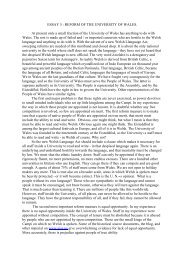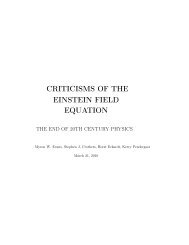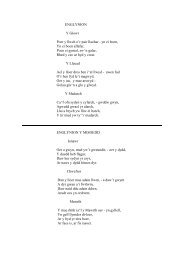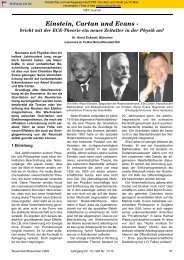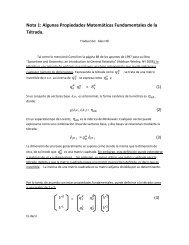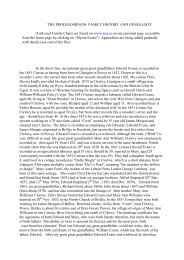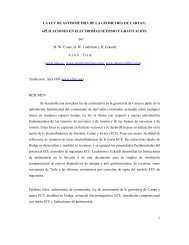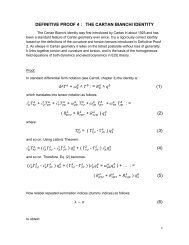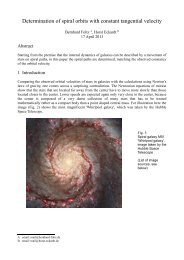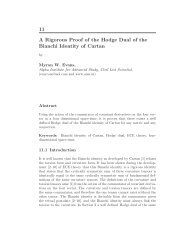Spin Connection Resonance in the Bedini Machine - Alpha Institute ...
Spin Connection Resonance in the Bedini Machine - Alpha Institute ...
Spin Connection Resonance in the Bedini Machine - Alpha Institute ...
You also want an ePaper? Increase the reach of your titles
YUMPU automatically turns print PDFs into web optimized ePapers that Google loves.
18 1 <strong>Sp<strong>in</strong></strong> <strong>Connection</strong> <strong>Resonance</strong> <strong>in</strong> <strong>the</strong> Bed<strong>in</strong>i Mach<strong>in</strong>e<br />
Computer algebra gives for this equation <strong>the</strong> general solution<br />
ω0 t − log (ω0) =c (1.84)<br />
with a constant c. This is a transcendent equation for ω0. S<strong>in</strong>ce c is arbitrary,<br />
<strong>the</strong>re is an <strong>in</strong>f<strong>in</strong>ite number of resonances <strong>in</strong> <strong>the</strong> whole <strong>in</strong>terval of real numbers<br />
for ω0.<br />
All fur<strong>the</strong>r <strong>in</strong>vestigations are made by a numerical model. As we have<br />
seen by analys<strong>in</strong>g Eq. (1.77) <strong>the</strong> vector potential Ar can be chosen freely.<br />
Consider<strong>in</strong>g <strong>the</strong> Bed<strong>in</strong>i mach<strong>in</strong>e, such a radial component can only be created<br />
by an asymmetric disturbance of <strong>the</strong> field potential of <strong>the</strong> transducer coil.<br />
This is achieved by <strong>the</strong> magnets of <strong>the</strong> wheel pass<strong>in</strong>g <strong>the</strong> transducer. We<br />
model <strong>the</strong>se pulses by a s<strong>in</strong>oidal function:<br />
Ar(t) =A1 s<strong>in</strong> 6 (ωt) (1.85)<br />
with an arbitrary amplitude A1 and a time frequency ω. This function and<br />
its time derivative are shown <strong>in</strong> Figs. 1.3 and 1.4 for three frequencies. With<br />
this ansatz, Eq. (1.79) takes <strong>the</strong> form<br />
ω0(t) =−6 ωcot(ωt). (1.86)<br />
This function has vertical tangents where <strong>the</strong> values approach <strong>in</strong>f<strong>in</strong>ity, see<br />
Fig. 1.5 for a plot of |ω0| for three frequencies <strong>in</strong> a logarithmic scale. Consequently,<br />
<strong>the</strong> derivative shows also this behaviour (Fig. 1.6).<br />
Eq. (1.78) has been solved numerically for Aϕ. The driv<strong>in</strong>g force f2 was<br />
assumed to be <strong>in</strong> proportion to <strong>the</strong> “symmetry break<strong>in</strong>g” potential Ar. With<br />
ω0 hav<strong>in</strong>g <strong>the</strong> s<strong>in</strong>gular behaviour, <strong>the</strong> solution spans a remarkable order of<br />
magnitude and is vulnerable to numerical <strong>in</strong>stabilities. Therefore <strong>the</strong> solution<br />
was checked by <strong>in</strong>sert<strong>in</strong>g it back <strong>in</strong>to Eq. (1.78) and check<strong>in</strong>g for equality<br />
with f2. In all cases <strong>the</strong> equality was ma<strong>in</strong>ta<strong>in</strong>ed with<strong>in</strong> sufficient precision.<br />
The result (Fig. 1.7) shows giant resonance peaks over 15 orders of magnitude<br />
which occur <strong>in</strong> co<strong>in</strong>cidence with <strong>the</strong> structure of ω0. Obviously <strong>the</strong>se peaks<br />
correspond to <strong>the</strong> peak signals <strong>in</strong> <strong>the</strong> Bed<strong>in</strong>i mach<strong>in</strong>e. The time frequency is<br />
to be identified with <strong>the</strong> pass<strong>in</strong>g rate of <strong>the</strong> magnets over <strong>the</strong> transducer. To<br />
make comparison even more appropriate, <strong>in</strong> Fig. (1.8) <strong>the</strong> derivative of Aϕ is<br />
shown which should correspond to <strong>the</strong> <strong>in</strong>duced voltage<br />
U<strong>in</strong>d = − ˙<br />
Aϕ. (1.87)<br />
The structure is very similar to that of Aϕ itself.<br />
Next we have tested <strong>the</strong> dependence of <strong>the</strong> solution on <strong>the</strong> driv<strong>in</strong>g force<br />
f2. It results that Aϕ is practically <strong>in</strong>sensitive to <strong>the</strong> form of f2, provided <strong>the</strong><br />
value is different from zero where ω0 has its poles. It is even sufficient to take



